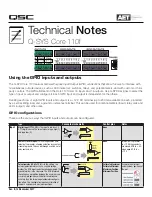
A P P E N D I C E S
page A – 16
WheatNet-IP
/ Apr 2009
To get started, open HyperTerminal and start a
new connection. The terminal session should be
setup using 9600Baud, 8 bit, no Parity, and no Flow
control.
For those who are familiar with the Cisco IOS you
may wish to jump ahead to the commands. For the
rest, keep reading and we’ll walk you through it step
by step.
Along the way we’ll even explain why we use the
commands below so that you have some basic under-
standing of what you are doing. Hopefully you will
walk away with some new found knowledge.
Privileged EXEC Mode
Now that we are connected to the switch let's login. When logging into a Cisco switch
under the default configuration, you are in user EXEC mode (level 1). In EXEC mode,
you have limited access to the status of the switch. However, you can't make any changes
or view the running configuration file.
Because of these limitations, you need to type enable to get out of user EXEC mode.
By default, typing enable takes you to “Privileged” EXEC mode (Level 15). In the Cisco
IOS, this level is equivalent to having root privileges in UNIX or administrator
privileges in Windows. In other words, you have full access to the switch.
Let’s get started on the configuration of your switch. Type “enable” command at the
prompt. When prompted, enter the password and press Enter again. If no password has
been defined just press Enter.
NOTE: The command prompt now ends with “#” indicating you are now at the
Privileged EXEC mode (Level 15).
Global Configuration Mode
To enter the IP address and Subnet Mask for the VLAN or configure the switch ports
you must first enter the configuration mode. To enter the global configuration mode on
the 2960G type “Config T” and press enter. This places the switch in Global
configuration mode and will allow configuration from the terminal window for the
selected interface. You should now have the switch (config)# prompt.
Configuring the VLAN Interface
A VLAN is a switched logical network that is segmented based on the function or
application. VLANs are virtual LANs but have the same attributes as the physical LAN.
VLANs allow a user to create a virtual broadcast domain in which traffic can be isolated
to keep it reaching unwanted destinations. Any switch port can belong to a VLAN, and
unicast, broadcast, and multicast packets are forwarded only to those end stations
assigned to that VLAN.
WheatNet-IP
/ Dec 2009
















































